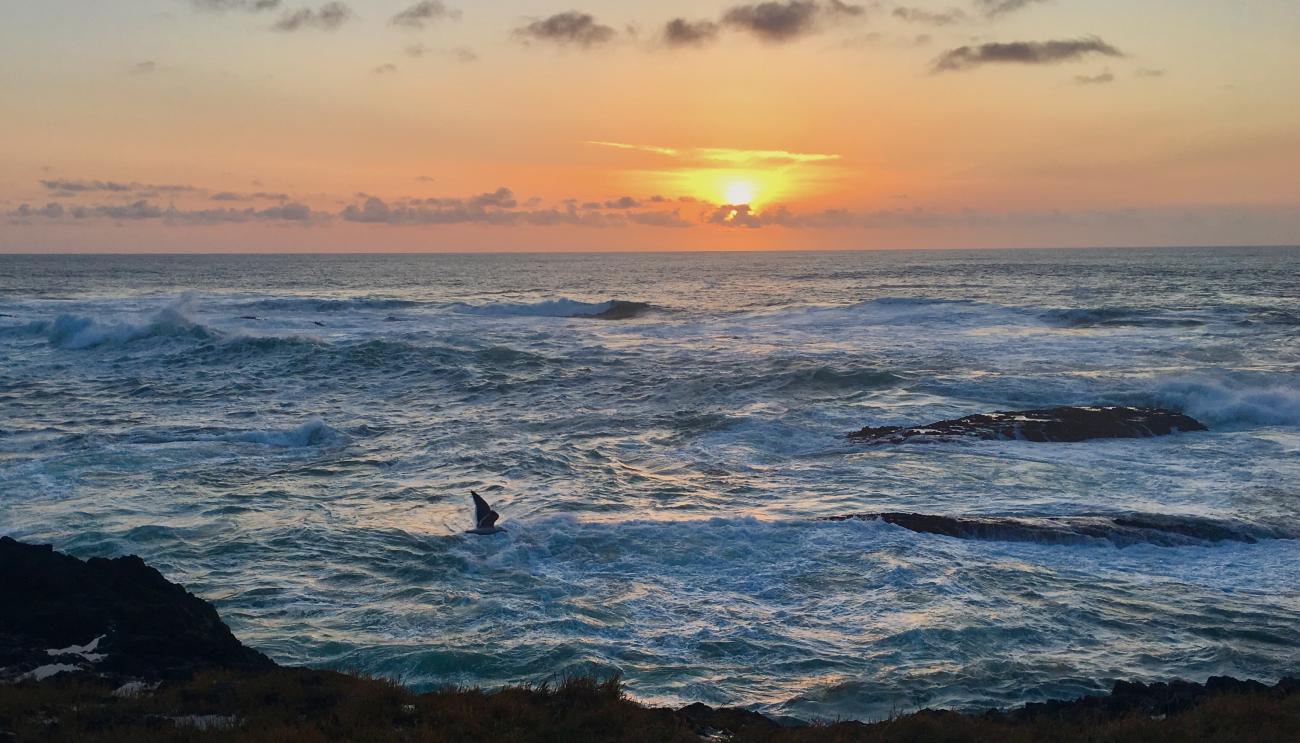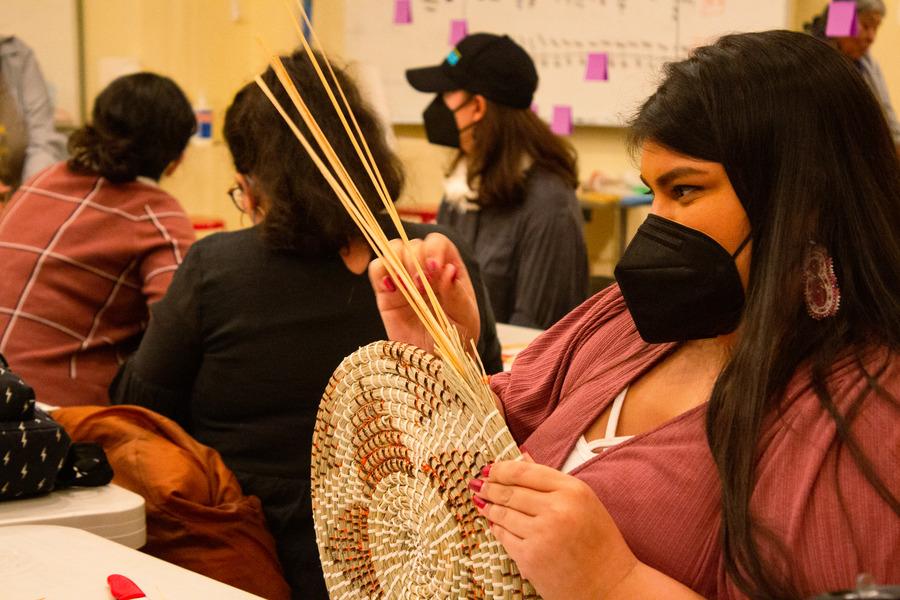
When most people envision Northern California, images of winding coastal roads, sheer cliffs, and mountainous, crashing waves appear in their minds-- redwood trees as tall as skyscrapers, and rocky beaches that span for hundreds of miles. What is typically not attached to the California postcard scenery, however, is knowledge of the American Indian Tribes that have been living in this region for countless generations, cultivating a deep spiritual and physical connection with both the ocean and the surrounding landmass.
Prior to European colonization, the Sinkyone Peoples and nearby Tribes lived in harmony with the natural world. Tribal communities lived the areas that became known as the Sinkyone Wilderness, regions of the Wild and Scenic Eel River Watershed, the “Lost Coast,” and vast portions of the region’s 3,000 year old rainforest. In the 1850s, the first European settlers began the exploitation of Indigenous Peoples and their sacred homelands. The Sinkyone and many neighboring Tribes were massacred to the point of near extinction and further subjected to disease, slavery, and forced removal to concentration camps (termed “reservations”).
The near-annihilation of the Sinkyone Peoples opened the door for timber operators to exploit the region’s expansive redwood forests for commercial gain. Redwoods were felled as early as the 1850s, but enhanced technology enabled logging to skyrocket from the 1940s through the 1980s. The insatiable hunger of the timber industry during this era resulted in a significant loss of redwood populations and crippled the flora and fauna whose livelihood was inextricably linked to the redwood ecosystem.
Despite this tragic history of environmental degradation and gross human rights violations, descendants of the original Sinkyone Peoples have survived and managed to retain and revitalize many of their sacred cultural traditions and spiritual connections to the land. Within the last 30 years they have also made groundbreaking strides in securing protections for Tribal traditional territories and fostering a new culture of collaboration between Indigenous Peoples and numerous partners.
In 1986, a group of seven federally recognized Tribes formed a consortium called the InterTribal Sinkyone Wilderness Council. Today, the consortium’s ten member Tribes include Cahto Tribe of Laytonville Rancheria, Coyote Valley Band of Pomo Indians, Hopland Band of Pomo Indians, Pinoleville Pomo Nation, Potter Valley Tribe, Redwood Valley Band of Pomo Indians, Robinson Rancheria of Pomo Indians, Round Valley Indian Tribes, Scotts Valley Band of Pomo Indians, and Sherwood Valley Rancheria of Pomo Indians. This nonprofit organization was designed to protect Sinkyone lands as well as safeguard, revitalize and honor traditional knowledge and cultural lifeways.
The InterTribal Sinkyone Wilderness Council is composed almost entirely of female Indigenous leaders (9 women and 1 man to be exact) representing the ten member Tribes. Under their leadership, the council has garnered a number of historical victories across the local, state, and national political arenas. The council’s achievements also showcase successful and progressive collaboration between Indigenous Peoples, NGOs, state institutions, and various governing bodies.
The council’s first landmark victory came to fruition in 1997 when it gained the necessary funds, legal approval, and public support to purchase nearly 4,000 acres of traditional Sinkyone land from the Trust for Public Land. More than 20 years later, the council’s newest victory has secured the protection of marine life off the coast of Northern California with the establishment of the world’s second largest network of Marine Protect Areas (MPAs).
Since 2005 the InterTribal Sinkyone Wilderness Council has spoken out against the testing and training operations of the U.S. Navy off the Northern Californian Coast. The U.S. Navy’s Northwest Training Range Complex (NWTRC) spans the coastlines and waters offshore from California, Oregon, and Washington as well as southeastern Alaska. Vast areas of the NWTRC are situated within the traditional territories of numerous coastal Tribes. Within the designated NWTRC waters, the Navy conducts “anti-submarine warfare exercises involving tracking aircraft and sonar, surface-to-air gunnery and missile exercises; air-to-surface bombing exercises; sink exercises; and extensive testing for several new weapons systems.” These measures have played a direct role in harming endangered marine life and threaten the biodiversity of the ocean’s ecosystem.
Many Tribal Nations also maintain a physical and spiritual investment in the continued prosperity of the coastline’s marine life. Since its foundation, the InterTribal Sinkyone Wilderness Council has spearheaded a multitude of conservation efforts both on solid land and within the ocean. Their dedicated efforts to protect the marine and coastal environments that are vitally connected to Sinkyone land and culture—together with a formal government-to-government consultation process between the Navy and the ten Tribes (initiated by the council in 2015)—greatly influenced the Navy’s December 2018 decision to exclude future training and testing activities from almost all state and federal marine waters situated within the 12-nautical mile wide area along the NWTRC’s western border.
In 2012, the InterTribal Sinkyone Wilderness Council, in partnership with Earthjustice, the Center for Biological Diversity, Friends of the Earth, Friends of the San Juans, Natural Resources Defense Council and People For Puget Sound, filed a federal lawsuit against the National Marine Fisheries Service. The complaint stated “in late 2010, the Fisheries Service gave the Navy a permit for five years of expanded naval activity that will harm, or ‘take,’ marine mammals and other sealife. The permit allows the Navy to conduct increased training exercises that can harm marine mammals and disrupt their migration, nursing, breeding or feeding, primarily as a result of harassment through exposure to the use of sonar.”
Rather than completely halt the Navy’s training exercises, the lawsuit demanded that “the Court to require the Fisheries Service to reassess the permits using the latest science and to order the Navy to stay out of biologically critical areas at least at certain times of the year” in order to “mitigate anticipated harm to marine mammals and biologically critical areas within the training range that stretches from Northern California to the Canadian border.”
“As an Indian woman and mother, I have heard and felt the cries, and also the happy times, of our ancestors. The suffering of our Mother Earth, the ocean and all our animal and plant relations calls out to us. This is why I am committed to protecting the rights of nature and our Peoples’ traditional rights, because our cultural ways of life depend upon the ocean’s health and abundance. The Navy’s military training and testing activities continue to destroy the life and the balance of our precious ocean. They threaten our Peoples’ cultural connections to our marine and coastal environments. I know that we have to take a stance and fight back. The Tribes of this region are strongly opposed to the Navy’s training and testing activities. We are asking that people submit comments to the Navy on the current Draft Supplemental EIS, to support the Tribes’ demands of stronger protections for marine life and the Tribes’ cultural lifeways,” said Priscilla Hunter, Tribal representative for Coyote Valley Band of Pomo Indians and co-founder and chairwoman of InterTribal Sinkyone Wilderness Council.
Mona Oandasan, representative for Round Valley Indian Tribes and a member of the Sinkyone Council, stated, “We are working together with the Navy representatives with ground rules agreed upon and learning how the Navy’s system moves. We, as Native people, share with those representing the Navy how our lives are a part of the world around us; we are not a separate living being but live interdependently. We continue our celebrations at different times of the year to honor the seasons, to give respect and celebrate that fact, and for the wealth of life the ocean shares with us. We, as Native people, come to the table to speak for and to protect the ocean’s life; the life within the ocean and our ways of life; to stop those activities that give imbalance to our world together. We are reaching out to all people to add their weight in protecting one of life’s greatest non-renewable resource.”
Investigations by the National Marine Fisheries Service, NATO, and veterinary and other scientific specialists have found that the U.S. Navy’s mid frequency sonar has contributed to beachings, strandings, and deaths of marine life across the globe.
TAKE ACTION:
The Sinkyone Council and its member Tribes continue to oppose the Navy’s training and testing activities, and are demanding stronger protections for the ocean and the Tribes’ cultural ways of life. June 12 is the deadline for public comment on the Navy’s current draft Supplemental Environmental Impact Statement (SEIS). The council and the Tribes ask that people express opposition to the Navy’s training and testing, as well as comment on the following specific issues, by submitting remarks to the Navy at https://www.nwtteis.com:
- The adequacy of the assessment of Tribal cultural impacts as well as environmental impacts from the Navy’s training and testing activities is especially important because these activities take place in the Pacific Ocean, which holds great cultural and spiritual significance for the Tribes and is critically important for the wellbeing of all people and lifeforms on this planet.
- The Navy should work meaningfully with the Tribes to develop measures that will reduce impacts to the Tribes’ cultural ways of life, including culturally and spiritually significant marine species and habitat that are vulnerable to Navy training and testing activities.
- The Navy should prohibit use of sonar within the 50-mile mitigation area. Sonar causes serious harm to the health and wellbeing of whales and other marine mammals.
- The “best available science” referenced in the draft SEIS should be expanded to meaningfully take into account Tribal Traditional Knowledge. Since time immemorial, Pacific coast Tribes have used and managed their traditional marine environment, including those areas situated within the Navy’s NWTRC.
- The Navy’s monitoring program should be expanded to include effects of training and testing beyond potential harm to species population levels. Population level effects are insufficient to fully take into account the potential harm that Navy training and testing may cause, because this standard does not fully incorporate the concept that impacts to Tribal cultural resources may not be manifested in physical impacts on marine species.
- The Navy should expand its list of environmental “stressors” to include those parts of the Study Area that encompass Tribal cultural resources, and the concept that those resources have intangible features, such as spiritual connections, which will be impacted by the training and testing.
- The cumulative effect of ocean acidification should be considered in the SEIS. The Draft SEIS concludes that the assessment in the Navy’s 2015 Final EIS that impacts to water quality from explosives and explosives byproducts in training and testing remains valid and does not need to be reconsidered. Based on studies conducted since 2015, this conclusion neglects to take into account the effect that changes in climate may have on the corrosive power of an increasingly acidic ocean. Specifically, the Draft SEIS does not consider the likelihood that acidification of ocean waters will accelerate corrosion of explosive devices and byproducts of training and testing.



